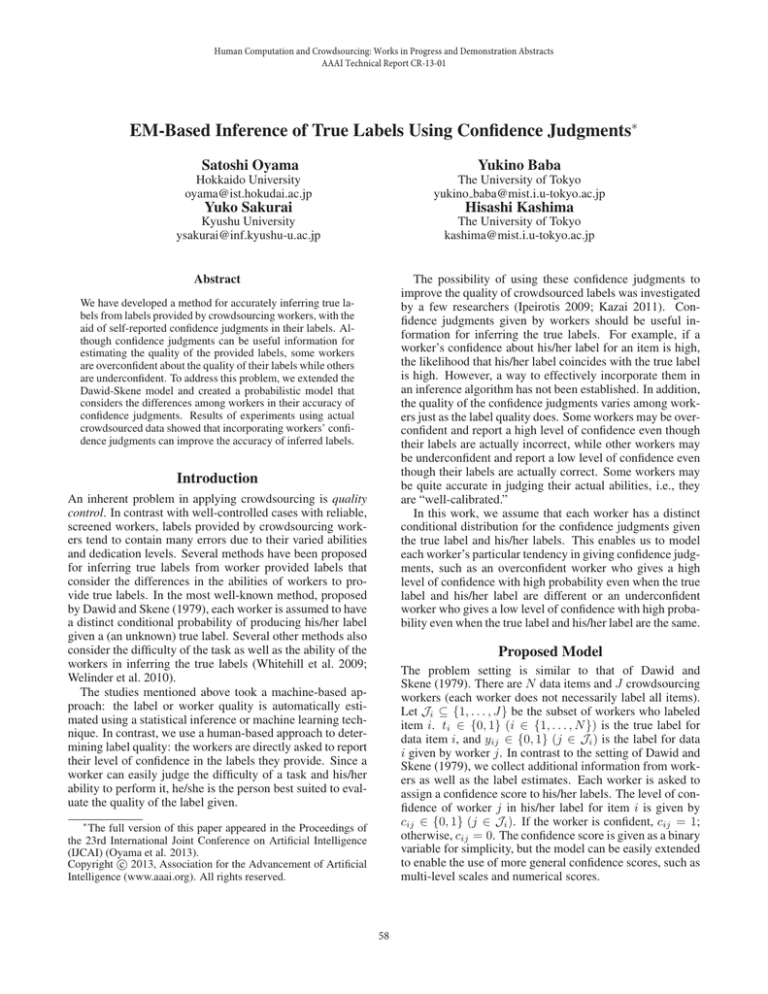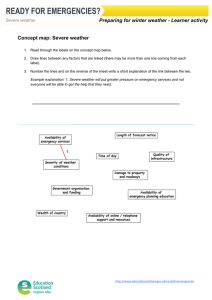EM-Based Inference of True Labels Using Confidence Judgments Satoshi Oyama Yukino Baba
advertisement

Human Computation and Crowdsourcing: Works in Progress and Demonstration Abstracts
AAAI Technical Report CR-13-01
EM-Based Inference of True Labels Using Confidence Judgments∗
Satoshi Oyama
Yukino Baba
Hokkaido University
oyama@ist.hokudai.ac.jp
The University of Tokyo
yukino baba@mist.i.u-tokyo.ac.jp
Yuko Sakurai
Hisashi Kashima
Kyushu University
ysakurai@inf.kyushu-u.ac.jp
The University of Tokyo
kashima@mist.i.u-tokyo.ac.jp
Abstract
The possibility of using these confidence judgments to
improve the quality of crowdsourced labels was investigated
by a few researchers (Ipeirotis 2009; Kazai 2011). Confidence judgments given by workers should be useful information for inferring the true labels. For example, if a
worker’s confidence about his/her label for an item is high,
the likelihood that his/her label coincides with the true label
is high. However, a way to effectively incorporate them in
an inference algorithm has not been established. In addition,
the quality of the confidence judgments varies among workers just as the label quality does. Some workers may be overconfident and report a high level of confidence even though
their labels are actually incorrect, while other workers may
be underconfident and report a low level of confidence even
though their labels are actually correct. Some workers may
be quite accurate in judging their actual abilities, i.e., they
are “well-calibrated.”
In this work, we assume that each worker has a distinct
conditional distribution for the confidence judgments given
the true label and his/her labels. This enables us to model
each worker’s particular tendency in giving confidence judgments, such as an overconfident worker who gives a high
level of confidence with high probability even when the true
label and his/her label are different or an underconfident
worker who gives a low level of confidence with high probability even when the true label and his/her label are the same.
We have developed a method for accurately inferring true labels from labels provided by crowdsourcing workers, with the
aid of self-reported confidence judgments in their labels. Although confidence judgments can be useful information for
estimating the quality of the provided labels, some workers
are overconfident about the quality of their labels while others
are underconfident. To address this problem, we extended the
Dawid-Skene model and created a probabilistic model that
considers the differences among workers in their accuracy of
confidence judgments. Results of experiments using actual
crowdsourced data showed that incorporating workers’ confidence judgments can improve the accuracy of inferred labels.
Introduction
An inherent problem in applying crowdsourcing is quality
control. In contrast with well-controlled cases with reliable,
screened workers, labels provided by crowdsourcing workers tend to contain many errors due to their varied abilities
and dedication levels. Several methods have been proposed
for inferring true labels from worker provided labels that
consider the differences in the abilities of workers to provide true labels. In the most well-known method, proposed
by Dawid and Skene (1979), each worker is assumed to have
a distinct conditional probability of producing his/her label
given a (an unknown) true label. Several other methods also
consider the difficulty of the task as well as the ability of the
workers in inferring the true labels (Whitehill et al. 2009;
Welinder et al. 2010).
The studies mentioned above took a machine-based approach: the label or worker quality is automatically estimated using a statistical inference or machine learning technique. In contrast, we use a human-based approach to determining label quality: the workers are directly asked to report
their level of confidence in the labels they provide. Since a
worker can easily judge the difficulty of a task and his/her
ability to perform it, he/she is the person best suited to evaluate the quality of the label given.
Proposed Model
The problem setting is similar to that of Dawid and
Skene (1979). There are N data items and J crowdsourcing
workers (each worker does not necessarily label all items).
Let Ji ⊆ {1, . . . , J} be the subset of workers who labeled
item i. ti ∈ {0, 1} (i ∈ {1, . . . , N }) is the true label for
data item i, and yij ∈ {0, 1} (j ∈ Ji ) is the label for data
i given by worker j. In contrast to the setting of Dawid and
Skene (1979), we collect additional information from workers as well as the label estimates. Each worker is asked to
assign a confidence score to his/her labels. The level of confidence of worker j in his/her label for item i is given by
cij ∈ {0, 1} (j ∈ Ji ). If the worker is confident, cij = 1;
otherwise, cij = 0. The confidence score is given as a binary
variable for simplicity, but the model can be easily extended
to enable the use of more general confidence scores, such as
multi-level scales and numerical scores.
∗
The full version of this paper appeared in the Proceedings of
the 23rd International Joint Conference on Artificial Intelligence
(IJCAI) (Oyama et al. 2013).
c 2013, Association for the Advancement of Artificial
Copyright Intelligence (www.aaai.org). All rights reserved.
58
Experiments
We propose using a probabilistic generative model of the
confidence judgments as well as the labels given by crowdsourcing workers. With this model, we can use workers’
confidence judgments as well as their labels to infer the
value of the true labels. Our models are given as a factorization of the joint distribution:
To evaluate the effectiveness of using confidence judgments
in inferring true labels, we conducted experiments using
Average
accuracy
1.00
0.90
Majority vote
0.80
Dawid-Skene
0.70
5
p({ti }, {yij }, {cij })
Y
Y
=
p(cij |yij , ti )p(yij |ti )p(ti ).
10
20
Number of workers per task
50
Proposed model
Figure 1: Results for image labeling
i∈{1,...,N } j∈Ji
Amazon Mechanical Turk. We chose ten images from the
Caltech-UCSD Birds 200 dataset and asked crowdsourcing
workers to choose one of two bird names as the label for
each image. We also asked them to report their level of confidence in each choice. We asked 100 workers to label the
same ten images. To see the effect of the number of workers per task on accuracy, we split the workers into groups
of equal size, inferred the true labels from the worker labels
and confidence judgments within each group, and averaged
the accuracies of the true labels obtained from each group.
We conducted experiments with four different group sizes:
5, 10, 20, and 50. The average accuracies for each group size
were obtained with majority vote, the Dawid-Skene model,
the proposed model. As shown in Figure 1, with 50 workers,
all three models and even a simple majority vote provided
sufficient accuracy due to the high level of redundancy. In
practice, however, the number of workers that can be used
for a task is limited due to cost. When the number of workers
was 5 or 10, the the model using the confidence judgments
achieved better accuracy than majority vote and the DawidSkene model.
We also conducted experiments using another dataset, one
containing 120 binary questions on general knowledge. See
Oyama et al. (2013).
The value of a true label for item i takes 1 with probability
pi and 0 with probability 1 − pi ; that is, it is sampled from a
Bernoulli distribution with parameter pi .
Worker labels {yij |j ∈ Ji } for item i are conditionally
(j)
(j)
independent given true label ti . α(j) = {α0 , α1 } repre(j)
sents the set of parameters for worker j, where α0 is the
probability of worker j giving label 1 if the true label is 0,
(j)
and α1 is the probability of worker j giving label 1 if the
true label is 1. Therefore, when ti = 1, label yij given by
worker j for item i is sampled from a Bernoulli distribution
(j)
with parameter α1 . Similarly, when ti = 0, label yij given
by worker j for item i is sampled from a Bernoulli distribu(j)
tion with parameter α0 .
Worker j’s confidence judgment cij for his/her label for
item i depends on the true label ti and his/her label yij , and
it is also sampled from a Bernoulli distribution. In the pro(j)
(j)
(j)
(j)
posed model, β (j) = {β00 , β01 , β10 , β11 } is the set of
(j)
parameters specific to worker j. Here, for example, β00 is
the probability that worker j’s confidence cij = 1 when true
label ti = 0 and worker j’s label yij = 0. In this case,
the confidence is sampled from the following distribution:
(j)
(j)
p(cij |ti = 0, yij = 0) = (β00 )cij (1 − β00 )(1−cij ) . When
ti = 0 and yij = 1, the confidence is sampled from the fol(j)
lowing distribution: p(cij |ti = 0, yij = 1) = (β01 )cij (1 −
(j)
β01 )(1−cij ) . The conditional distributions for the other two
cases, p(cij |ti = 1, yij = 0) and p(cij |ti = 1, yij = 1) are
similarly defined.
Acknowledgments
SO was supported by JSPS KAKENHI 24650061. YB and
HK were supported by the FIRST program. YS was supported by the JST PRESTO program.
References
Our goal is to infer the set of true labels {ti } given the set
of workers’ labels {yij } and the set of confidence judgments
{cij }. Similar to the approach of Dawid and Skene (1979),
we use the EM algorithm to obtain the maximum likelihood
estimate of model parameters {α(j) } and {β (j) }, with true
labels {ti } as latent variables. The EM algorithm for the
proposed model alternately performs two steps until convergence.
Dawid, A. P., and Skene, A. M. 1979. Maximum Likelihood Estimation of Observer Error-Rates Using the EM Algorithm. Journal of the Royal Statistical Society. Series C (Applied Statics)
28(1):20–28.
Ipeirotis, P. 2009. How good are you, Turker? http://www.behindthe-enemy-lines.com/2009/01/how-good-are-you-turker.html.
Kazai, G. 2011. In Search of Quality in Crowdsourcing for Search
Engine Evaluation. In ECIR.
Oyama, S.; Baba, Y.; Sakurai, Y.; and Kashima, H. 2013. Accurate
Integration of Crowdsourced Labels Using Workers’ Self-reported
Confidence Scores. In IJCAI.
Welinder, P.; Branson, S.; Belongie, S.; and Perona, P. 2010. The
Multidimensional Wisdom of Crowds. In NIPS 23.
Whitehill, J.; Ruvolo, P.; Wu, T.; Bergsma, J.; and Movellan, J.
2009. Whose Vote Should Count More: Optimal Integration of
Labels from Labelers of Unknown Expertise. In NIPS 22.
E-step: Estimate the expected values of unobserved variables {ti } by using the current estimates of parameters
{α(j) } and {β (j) }.
M-step: Estimate parameters {α(j) } and {β (j) } by using
the current expectations of {ti }.
59





